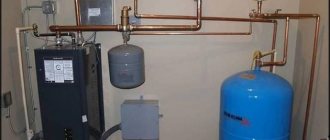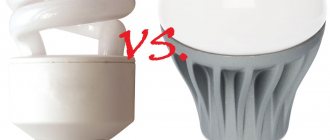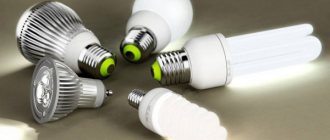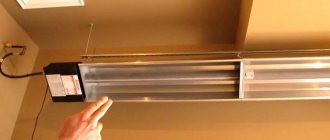General information about heating in timber houses
Houses made of timber have low thermal conductivity of the walls, so the heat stays in them for a long time. In rooms of such a structure, it is possible to achieve the required temperature much faster (with the same wall thickness).
To take advantage of the benefits of wood as a building material, it is necessary to establish an efficient heating system that will evenly distribute heat inside the house. In this case, it is necessary to take into account all the features of the building design. The choice and arrangement of heating is carried out taking into account such criteria as cost, complexity of work, prompt installation, simple maintenance, efficiency, and so on.
When planning to heat a house made of laminated veneer lumber, you can consider any type of system that the modern equipment market offers. In this article we will look at each of them separately. Before you start choosing the type of heating in a house made of timber, you need to calculate the area of the heated premises. This will help determine the required thermal power of the equipment.
For calculations, you need to find the product of the area and 100 watts. The resulting value will correspond to the power required to maintain a temperature of +25 °C in the premises of a timber house if the temperature outside is –30 °C. Accordingly, in milder climatic conditions the thermal power consumption will be lower.
Selection of pipes for distribution
The final result, which consists in preserving and saving heat, depends on the quality of each system part, so the longest elements - pipes - must also be given some attention.
From a technological point of view, pipes and fittings must have the following qualities:
- strength;
- ease;
- suitability for repair;
- tightness;
- low noise level.
Low cost is also an important component when choosing, because heating system equipment requires a large number of products for various purposes. Polypropylene pipes are the best option for self-assembly of a heating system
You can learn to use a soldering machine for stitching pipes in 10 minutes
Polypropylene pipes are the best option for self-assembly of a heating system. You can learn to use a soldering machine for stitching pipes in 10 minutes
Nowadays, hardly anyone will undertake the installation of wiring from metal pipes. Steel, copper and galvanized products are becoming a thing of the past, giving way to cheaper and more functional analogues.
The best alternative is polymer products. which can be divided into three groups:
- polypropylene;
- metal-plastic.
The advantages of polypropylene pipes are low cost, ease of welding, and long service life. Disadvantage: lack of elasticity. When replacing a pipe, you will have to change the entire fragment from connection to connection.
On a long section of the pipeline, polypropylene pipes sag, as they have an expansion of 6 mm/5 m. Strong fixation is ensured using brackets or clips mounted in the wall at intervals of 1-1.1 m
Durable metal-plastic pipes are resistant to sudden temperature changes. Capable of serving without major repairs for up to 30 years. The weak point is the connecting elements - fittings with an unreasonably narrowed cross-section. If the coolant freezes, a breakthrough is likely.
When choosing pipes, focus on the main technical indicators of the equipment and the type of coolant.
Tips on what to consider when choosing heating
When choosing heating systems for a house made of timber, in addition to their cost, it is necessary to take into account the complexity of installation and operating costs. It is necessary to analyze the efficiency of the equipment, as well as the ease of operating the system and monitoring the temperature in the premises. It is worth considering the level of complexity of carrying out preventive measures and repair work, operational safety and environmental characteristics.
When designing a house made of timber for permanent residence, you should pay attention to heating systems that use liquid or electric current as a coolant. This is precisely the conclusion that arises after comparing the advantages and disadvantages of different heating options. The same result will be obtained when comparing the cost of heating a house using different systems.
If you plan to build a country house from timber for seasonal living, then networks with a liquid coolant turn out to be completely ineffective. For such a house it is better to equip a fireplace or electric heating.
Standards and requirements for autonomous heating
Before designing a heating structure, you need to look into SNiP 2.04.05-91, which sets out the basic requirements for pipes, heating devices and shut-off valves.
General standards boil down to ensuring a comfortable microclimate in the house for the people living in it, properly equipping the heating system, having previously drawn up and approved the project.
Many requirements are formulated in the form of recommendations in SNiP 31-02, which regulates the rules for the construction of single-family houses and their provision with communications.
Temperature-related provisions are specified separately:
- the parameters of the coolant in the pipes should not exceed +90ºС;
- optimal indicators are within +60-80ºС;
- the temperature of the outer surface of heating devices located in the direct access zone should not exceed 70ºС.
It is recommended to make pipelines for heating systems from brass, copper, and steel pipes. In the private sector, polymer and metal-plastic pipe products approved for use in construction are predominantly used.
Pipelines for water heating circuits are most often laid in an open way. Hidden installation is allowed when installing “warm floors”
The method of laying the heating pipeline can be:
- Open. Involves laying on building structures with fastening with clips and clamps. Allowed when constructing circuits made of metal pipes. The use of polymer analogues is permitted if their damage from thermal or mechanical influence is excluded.
- Hidden. It involves laying pipelines in grooves or channels selected in building structures, in baseboards or behind protective and decorative screens. Embedding of the circuit is allowed in buildings designed for at least 20 years of operation and with a pipe service life of at least 40 years.
The open method of laying is a priority, because the design of the pipeline route must provide for free access to any element of the system for repair or replacement.
Pipes are hidden in rare cases, only when such a decision is dictated by technological, hygienic or structural necessity, for example, when installing “warm floors” in a concrete screed.
When laying pipelines for systems with natural coolant movement, it is necessary to maintain a slope of 0.002 - 0.003. Pipelines of pumping systems, inside which the coolant moves at a speed of at least 0.25 m/s, do not need to provide slopes
When laying an open highway, areas crossing unheated premises must be provided with thermal insulation that corresponds to the climatic data of the construction region.
Autonomous heating pipelines with a natural type of circulation must be installed in the direction of the coolant flow, so that the heated water reaches the radiators by gravity, and after cooling in the same way, moves along the return line to the boiler. The mains of pumping systems are constructed without a slope, because there is no need for it.
The use of different types of expansion tanks is stipulated:
- open, used for both pumping and natural forced systems, should be installed above the main riser;
- closed membrane devices, used exclusively in forced systems, are installed on the return line in front of the boiler.
Expansion tanks are designed to compensate for the thermal expansion of the liquid when heated. They are needed to dump excess into the sewer or simply onto the street, as is the case with the simplest open options. Closed capsules are more practical because they do not require human participation in adjusting the pressure of the system, but they are more expensive.
An open type expansion tank is installed at the highest point of the system. In addition to providing a reserve for liquid expansion, it is also entrusted with the task of removing air. Closed tanks are placed in front of the boiler; air vents and separators are used to remove air
When choosing shut-off valves, preference is given to ball valves; when choosing a pumping unit, preference is given to equipment with a pressure of up to 30 kPa and a capacity of up to 3.0 m3/h.
The budget opening variety needs to be refilled periodically due to normal liquid evaporation. For their installation, it is necessary to significantly strengthen the attic floor and insulate the attic.
It is recommended to install radiators and convectors under windows, in places convenient for maintenance. The role of heating elements in bathrooms or toilets can be played by heated towel rails connected to heating communications
Which heating is better for a house made of timber: autonomous or local?
The heating system option must be chosen at the house design stage. In this case, it is necessary to take into account its intended purpose. For a country house where people do not live permanently, the heating requirements are not as stringent as for a cottage where a family with children permanently lives.
Autonomous heating systems operate independently of centralized heating networks. These systems are currently the most common heating option for low-rise buildings. Individual heating is the most effective and economical option for a private house made of timber.
There are also local heating devices. These include various convectors, heat guns, fireplaces, infrared heaters, stoves, etc. Each such device can provide a comfortable temperature only in a small space. Local heaters are installed in a separate room and are most often used to heat objects not intended for permanent residence.
How to heat a house
People live in an individual house all year round, so it is possible to use water systems - radiator and floor heating. Often a fireplace is used as an additional heat source. Electric heating is very convenient and does not require constant supervision, but it is expensive.
The best option for do-it-yourself heating in a private house is to install a “warm floor”. A radiator heating system is easy to install, but it is less economical.
In addition, in middle and northern latitudes, when modernizing an old, uninsulated house, a “warm floor” may not provide sufficient heating of the house, and additional heating sources will have to be used, including the installation of radiators. The electrical system is directly dependent on uninterrupted power supply.
Stove heating for a house made of timber: pros and cons
Stove heating is considered the most ancient option for ensuring a comfortable temperature in the house. The operating principle of the furnace is based on obtaining thermal energy as a result of burning solid fuel (wood, coal, briquettes, etc.). In modern houses made of timber, the stove is used quite rarely and only as a backup heat source.
Stove heating provides heat to the room in which the stove itself is located. The advantage of stoves is that they can operate on different types of fuel. This circumstance determined their popularity in many countries of the world.
However, stove heating also has its disadvantages. Some owners of private houses believe that one stove is enough to heat their home. But if a house made of timber has more than 3 rooms or, for example, two floors, then you will need to install two or even three stoves. Such a solution will take up a lot of usable space. In addition, owners of wooden houses should not forget that stove heating is a fire hazard.
Advantages and disadvantages
Heaters have become very popular lately. If there is no gas on your site, then you can heat your home using this method. The main advantages of electric heating of a wooden house include:
If you position all the heaters correctly, then the heating effect will be several times higher than with stove heating.
- This type of heating involves no emissions into the atmosphere.
- You can install the heaters yourself.
- Thanks to electronic thermostats, you can easily regulate the heat in your home.
- If you choose the right manufacturers, then repairs will rarely be necessary.
- You no longer need to stock up on firewood or coal.
- Each type of electric heater for a wooden house is compact.
- Electric heating can be used as main or additional.
In addition to the advantages, heating in a wooden house can also have disadvantages, which include:
- Today, the power grid can often be shut down for repairs. If there is no light, then there will be no heat.
- You will need to purchase a diesel generator. In the event of a power outage, your system will operate reliably.
- You will need to change the meter to a two-tariff one.
- Electric heaters are considered fire hazardous devices. In order to protect your home, you must take into account all the recommendations.
If you don’t know which electric heating to choose for a wooden house, then watch the video.
Advantages of electric heating of a house made of timber
Electric heating is an effective solution for any home. This option allows you to uninterruptedly heat the rooms and accurately maintain a comfortable temperature in them. Such systems are used in many European countries.
Electric heating is versatile. Electric boilers and various heaters can be used for local and autonomous heating systems in timber houses.
The advantage of this option is its affordable cost, ease of control, minimal maintenance requirements, ease of installation, the ability to regulate the temperature using a timer, compact size of the equipment, low noise and no emissions of combustion products. To install electric heating in a house made of timber, you do not need special approval of the project from administrative authorities.
Recommended reading:
- Options for laminated timber houses for every taste and budget
- Construction technology of a half-timbered house
- Types of foundations for a private house
Additional benefits can be obtained by installing electrically heated floors. In this case, the air in the rooms will not become too dry and drafts characteristic of systems with water radiators will not occur. When installing electric heated floors, it becomes possible to accurately and easily control the temperature in the room. At the same time, heating devices will not interfere with the interior design of the premises.
The disadvantage of electrically heated floors is the complexity of installation and repair, the high cost of heating due to the high cost of electricity. Even economical systems in the cold season will consume several tens of kW per day during the day.
Installation of a "warm floor" system
We use heating mats
Stage 1: it is most convenient to use electric heating mats, although they will cost 20-25% more than cable. A groove is made in the wall and floor where the cable in a corrugated tube will go, connecting the heating mats to the energy source, and the temperature sensor. Then all debris and dust are removed from the floor surface. Heating mats can be placed directly on old tiles. The mat mesh is easy to cut, and if the mat is rotated, a cut can be made, but the heating cable must not be touched.
Stage 2: the mat is attached to the floor using a heat gun or tape. Sometimes an adhesive layer on the mesh is already applied to the surface of the mat, and the mat itself sticks well.
Stage 3: a layer of tile adhesive is applied on top of the mat. You need to let it dry completely for 5-7 days.
Stage 4: all connections must be made and the thermostat connected. The functionality and serviceability of the heating system is checked.
Stage 5: You can lay the floor covering on the completely dried adhesive base.
We use a cable
main source of heating
Stage 1: the floor is cleared of old tiles or other material before laying the heat insulator. All debris is swept out and dust is removed.
Stage 2: sheets of heat insulation are laid out on the cleaned surface. The joints between the sheets are taped.
Stage 3: a reinforcing mesh is laid on top of the thermal insulator and an intermediate screed no thicker than 3 cm is poured. Wait 3-5 days until it dries completely.
Stage 4: after the screed has completely dried, mounting tape is applied to it.
Stage 5: a detailed cable laying diagram is drawn up. You need to start laying from the bridge connecting the wiring to the thermostat. It is necessary to take into account the cable manufacturer's recommendations regarding the minimum bending radius of the cable and the minimum distance between the cable threads. Do not run the cable under areas where plumbing fixtures and furniture will subsequently be installed.
Stage 6: the thermostat is installed inside the corrugated tube. All components of the electrical system are connected.
Stage 7: after checking the operation of the heating system, a second screed 3-10 cm high is laid. You must wait a month until it dries completely.
Stage 8: Now you can lay any flooring.
Is gas heating suitable for a log house?
Autonomous gas fuel heaters are used very rarely in local heating systems for houses made of timber. This is due to the presence of open fire in such devices. There is another significant drawback of gas heaters. During fuel combustion, they burn oxygen in heated rooms.
At the same time, gas fuel is the most common energy carrier for autonomous heating systems in private homes. The main condition for such systems is the ability to connect to the central gas main. Modern heating boilers that run on gas are characterized by their efficiency, automated control system and high power. Such a unit can effectively heat a house made of timber with an area of several hundred square meters. There are floor-mounted and wall-mounted models of gas boilers. The latest devices can be used without installing separate chimneys. The main disadvantage of autonomous heating using such boilers is the high cost of laying a gas pipeline to the house. In the absence of such an opportunity, some developers use gas holders or liquefied gas cylinders. Such decisions are not always economically justified.
Despite all its shortcomings, gas heating is considered the most convenient and cost-effective option for a house made of timber. Very often, floor heating systems are used together with such boilers. In private houses with a small area, gas convectors can be installed. To install heating systems using gas fuel, you will need equipment such as a gas boiler (the best option is automatic wall-mounted models with a pump), polypropylene gas pipes and special shut-off valves.
It is important to design and professionally install a chimney for a gas boiler. A disk with a small hole is built into its base. To calculate and arrange the chimney structure, you will need an experienced stove maker. It is not allowed to place a gas boiler in basements. Such equipment is located in the hallway or in the kitchen. Installing a convector allows you to achieve more economical operation of the heating system, since it becomes possible to regulate the temperature in individual rooms of a log house.
Liquid fuel - an alternative to “blue”
When there is no gas pipeline in a wooden house, and there is little hope for electrical networks, installing a diesel boiler can be a good solution for heating. The installation and operation of a system based on it requires significant expenditure (both the boiler itself and the fuel will be expensive), but the advantages are significant: the homeowner gains independence from gas networks, without losing the opportunity to enjoy the automatic operation of highly efficient equipment. The efficiency of liquid fuel boilers is almost the same as that of gas boilers. “Getting” diesel fuel is not a problem – if only there were the means. And they can deliver it to any locality.
The liquid fuel boiler should be located in a specially equipped boiler room. All the requirements for this room are, in principle, easily fulfilled - there is no need to worry. The only thing that can upset you if a wooden house is small is the need to sacrifice a couple of square meters of usable space.
Tanks for diesel fuel can be installed in the boiler room or buried in the ground
Other modern types of heating a house made of timber
Heating a house made of timber with convectors
Convectors powered by electricity are easy to install and easy to maintain. They are usually attached to the wall or installed on the floor. To save free space, electric convectors can be mounted directly into the floor near the baseboard.
Such equipment quickly reaches the required operating temperature. Moreover, their efficiency reaches 90%.
Modern models of electric convectors are capable of operating from a network with a voltage of 150 to 242 V. Unfortunately, such a unit is capable of heating only the room of the timber house in which it is located. Considering this circumstance, it is necessary to correctly select the power of the convector for each room. For rooms with an area of about 20 m2, an electric convector with a power of 2000 W is required.
In addition to power characteristics, other equipment parameters must be taken into account. The most important points include the presence of a built-in temperature controller. It can be mechanical or electronic. The most advanced convectors have special sensors that can be programmed to maintain a special temperature regime, taking into account the days of the week and time of day.
The advantages of electric convectors include the small size of the equipment and uniform distribution of heat throughout the room. The most compact models can be hidden in the baseboard.
It should also be noted that there are disadvantages in convectors operating from the electrical network. The disadvantages of such devices are especially evident in houses made of timber with high ceilings. In such buildings, the heat generated by electric convectors is collected under the ceiling. At the same time, the movement of warm air currents contributes to the appearance of drafts and raises dust from the floor. If an effective ventilation system is installed in the room, the convector significantly loses efficiency. Some of the heated air will be removed by ventilation, so the room may be somewhat cool. If there are natural ventilation systems in a house made of timber, there is no such effect.
Liquid fuel
Liquid fuel boilers are often considered as an alternative to gas-fired appliances. If there is no possibility of connecting to a central gas pipeline, in houses made of timber, boiler equipment that runs on diesel fuel can be used. Such boilers have a high cost, but also have a number of advantages: the affordable price of diesel fuel and the ability to install autonomous heating without connecting to gas mains while maintaining the ability to automate the heating system control process. The efficiency of such equipment can be comparable to that of gas boilers. It should be taken into account that a separate spacious boiler room is required to accommodate the liquid fuel boiler.
Air heating
Air heating systems for houses made of timber are widely used in European countries, but are not yet well known in the Russian Federation. The operating principle of such systems is based on the movement of heated air masses in an air duct system, which is distributed throughout all rooms of the building. Thus, not only is a comfortable temperature maintained in the rooms, but the timber house is also effectively ventilated.
Air heating systems are characterized by high efficiency. They are distinguished by functionality and provide an aesthetic appearance to the interiors of a house made of timber. The level of heat transfer of such equipment is higher than that of other types of heating equipment. It should be taken into account that air ducts for supplying warm air are designed before the house is built, and their repair is a rather labor-intensive operation.
The principle of operation of air heating is that outside air is supplied to the air heater using a fan, and then distributed to individual rooms of the house. Air masses that enter the system from the street can be cleaned of dust, foreign odors and various bacteria. If necessary, the air can be additionally saturated with oxygen. Liquid fuel equipment or gas heaters can be used to heat the outside air.
The disadvantage of such systems is their high price and cumbersome ventilation ducts.
Air heating in a house made of timber must be designed and installed under the strict supervision of specialists, which can also be attributed to the disadvantages of such a system.
Warm floor
There are two types of heated floors - water and electric. Such systems provide additional comfort. If there are heated floors in a house made of timber, warm slippers will not be needed in winter, and small children will be able to play on the floor without the risk of catching a cold. Modern underfloor heating systems are easy to install, but it is better to design them at the stage of building a house. In this case, you will not have to disrupt the aesthetics of the interior after the renovation is completed.
In water-heated systems, water is used as a coolant, which circulates through a closed circuit built into the floor screed. Water is heated in such a system using a heating boiler.
To install electrically heated floors, a special cable is laid in the screed.
Advantages of heated floors:
- thermal energy is evenly distributed throughout the room;
- the air in the rooms of the house does not dry out;
- when using heated floors there is no risk of drafts;
- such systems do not affect the interior design of premises;
- simple room temperature control.
Flaws:
- labor-intensive installation;
- increasing the width of the screed reduces the height of the room;
- expensive repairs;
- The disadvantage of electric heated floors is the high cost of electricity.
The most common option for heating houses made of timber in our country is a system with a liquid coolant, which, as a rule, is water. It circulates in a closed loop: “heating boiler - radiators”. Residential buildings use systems with forced and natural circulation of coolant fluid. Natural circulation occurs due to the difference in density of cold and heated water. Such systems can be used in timber houses whose area does not exceed 100 m2. For forced circulation of the coolant, the heating system is equipped with a special pump, which creates the necessary pressure in the line.
The advantage of water heating is the high heat capacity of water and the low cost of installation. At the same time, heating systems with natural coolant circulation are completely autonomous, since they can operate regardless of the presence of a connection to the electrical network. The disadvantages of this option include the short length of the system, which can only be used to heat houses with a small area.
Heating with forced water circulation can be used for houses made of timber of any size. But it should be taken into account that in this case the operation of the heating equipment will depend on the availability of a connection to the electrical network. In addition, the arrangement of such systems will be more complicated, since it is necessary to install additional equipment. The main disadvantage of water heating is the need to drain water in winter when the heating is turned off (water can freeze in pipes and radiators, which will lead to cracks). That is why such systems are rarely used for heating dachas, or instead of water, non-freezing liquids are used as a coolant.
Baseboard heating
A good option for a house made of timber is to install baseboard heating. In this case, the heat is evenly distributed from the baseboard along the wall surfaces, which prevents the formation of condensation and water does not get inside the wooden walls.
According to its characteristics, baseboard heating resembles heated floors, which have recently become one of the most popular solutions for houses made of timber.
Combination boilers
Leading brands engaged in the production of heating equipment for private homes offer a wide selection of autonomous heating boilers that can operate on several types of fuel (for example, wood, briquettes and electricity). Such models allow owners of log houses to heat their premises even during a power outage.
The cost of heating a house made of timber consists of two components - the price of equipment and the cost of installing the heating system. In order for the heating system to operate economically and without failures in the future, higher costs will have to be incurred when purchasing, connecting and installing equipment.
Features of heating systems
The most common heating in Russia is using gas, since it is quite cheap. In addition, the installation of a gas-powered heater is quite simple; you can install it yourself.
That is why quite a lot of people choose the type of heating using gas (cheaper than heating with electricity and convectors).
To install a heater, you need to properly design your house. You should also have a diagram for installing the heater at hand to make installation more convenient.
In addition, you need to mark the location of the gas pipes on the house design. If they are not there, you will have to install a gas pipeline or buy a gas cylinder.
Video:
Water heating is one of the most popular. The principle of its operation is that the water in the boiler is heated and then flows through the pipes, filling the house with heat. The same principle applies to apartment buildings.
In addition to the pipes, water enters the radiators, and from there it returns back to the boiler and is heated again. This type of heating is often supplemented with convectors (wall-floor heater), especially where a single-pipe circulation system is installed.
Water can circulate through pipes naturally or artificially, using additional pressure.
To move water naturally, a single-pipe system is used; for an artificial method, a two-pipe system is used.
It should be remembered that in a single-pipe system it will most likely not be possible to maintain the temperature at the same level, since distant radiators will receive water at a lower temperature for heating.
Therefore, a single-pipe system is better suited for small rooms; it is not recommended to install it in a large house.
The most obvious disadvantage of a single-pipe system is insufficient heating of the lower radiators, which will lead to the fact that different floors of the same house will be heated to different temperatures.
In addition, this option will be optimal only if the boiler is located below the level of the radiators, because otherwise there will not be enough pressure to circulate water.
It should be noted that this option is quite economical, since it does not require a large amount of materials.
As for the temperature, it can be leveled by correctly setting the radiators or choosing those heaters that have a larger number of sections. In addition, radiators can be placed in places where the temperature is lowest.
A diagram of the house will help you understand how many radiator sections will be needed to heat a room of a given size, and where it is best to place the radiators.
Installation of a two-pipe system requires the installation of an additional water tank. You will also need a pump to be able to install the boiler in any room.
It is better to take boilers with a pump included. To better understand which types of heaters are best suited, you can ask a specialist.
Types of heating radiators for a house made of timber
To install a water heating system for a house made of timber, in addition to boilers, it is necessary to select the most suitable pipes, connecting fittings and radiators. The modern heating equipment market offers a wide selection of different types of batteries. Sectional radiators continue to be the most popular. For their production, materials such as cast iron, steel and aluminum alloys can be used. The most recent developments in the field of heating equipment include bimetallic radiators.
Cast iron is a traditional material for the production of heating batteries. Products made from it are distinguished by their heavy weight and high thermal inertia. Cast iron radiators are attractive due to their reliability and long service life.
Modern cast iron batteries differ from traditional Soviet models in a more attractive design.
Aluminum radiators are light in weight, but do not withstand pressure drops in the system and are therefore considered not reliable enough. Bimetallic batteries are made from steel and aluminum, so they combine the best characteristics of these materials. The aluminum body can significantly reduce the weight of the structure, and steel pipes transfer heat well and are reliably protected from corrosion. The presence of a large selection of different radiator models creates certain difficulties for buyers when choosing products for heating a house made of timber. To avoid making mistakes, it is worth consulting with experienced specialists who are well acquainted with modern heating equipment at the heating design stage. Special attention should be paid to the qualified installation of such systems.
Subtleties of radiator selection
Radiators are one of the most important components of the system. After all, they distribute heat throughout the living space. Therefore, their choice should be taken with full responsibility, and not buy the first product you come across.
Batteries are divided into categories depending on their design and the material from which they are made. Since a wide assortment can drive an unprepared buyer into a dead end, before going to the store it is necessary to understand the advantages and disadvantages of each type.
Aesthetics of aluminum structures
Such products appeared in Italy more than 35 years ago. Since their invention, aluminum heating radiators immediately became popular and won the recognition of professionals.
When choosing a heating radiator, first of all you should familiarize yourself with the material of the sections. The heat transfer of the battery, its service life and weight depend on it
And this is not at all surprising, because these structures are distinguished by their lightness, high heat transfer, and attractive design. But they are poorly resistant to corrosion and are susceptible to airing.
Aluminum batteries can be cast or extruded. The first type is a monolithic structure, and the second is a blank formed by a press, from which finished products are subsequently cut.
Cast structures are considered more reliable and durable. In other respects, their analogues are in no way inferior to them.
Aluminum batteries are relatively lightweight. This makes them easy to transport and connect, something you can do yourself
Panel steel radiators
Steel is an excellent heat conductor. Therefore, batteries made from it are considered the most effective and are recommended for installation by all specialists. In addition, they are a monolithic structure, which greatly simplifies installation.
Provided that steel radiators are used in a house or country house with an autonomous heating system, they have no disadvantages. If all recommendations are followed, the service life can reach 30 years.
Batteries of this type are often supplemented with heat exchangers. But this in no way affects the appearance of the structure.
Good old cast iron
Cast iron radiators were first used more than a century ago. But even today they have not lost their relevance and are actively installed in heating systems.
The reason for this is its ease of maintenance and simply enormous service life - cast iron will faithfully last for about 50 years. At the same time, it retains heat well. The products take a long time to heat up, but after turning off the heating they will heat the room for a long time.
Taking into account all their advantages, cast iron appliances have only one insignificant disadvantage - they are heavy. Thus, the weight of one section can reach 6 kg, and the weight of the entire battery can be 36 kg.
Even in comparison with bimetallic and aluminum products, cast iron structures are a good and universal solution with many advantages
Tubular radiators made of steel
Tubular batteries, as a rule, are classified as products in the highest price segment. They fully comply with all quality standards and have a number of advantages over their analogues.
First of all, such structures can easily withstand sudden changes in pressure, and in the event of a heat cut, the battery will not become air-filled.
Also, tubular radiators have a smooth surface both outside and inside. Thanks to this, they have an attractive appearance, due to which they will harmoniously fit into any interior.
Tubular steel radiators are an expensive proposition. But at the same time, they last for about a quarter of a century, which completely pays for the costs.
Modern bimetallic structures
These types of batteries are made from an alloy of aluminum and steel. These metals have completely different characteristics, and as a result of their combination, a material with excellent performance is obtained.
More precisely, these radiators show high thermal conductivity and can easily withstand water hammer. If assembled with high quality, bimetallic products last about 50 years. But they are quite expensive.
Even despite the high price, it is better to spend money once and buy a bimetallic radiator from a reliable supplier. Thanks to its long service life, it will fully justify the investment.
Built-in floor convectors
This heating device is a tube made of copper and aluminum through which the coolant moves. The main advantage of floor convectors is the ability to build them directly into the floor.
In this case, the structure does not take up precious residential square meters, but at the same time warms the building well. The only thing that comes out is the decorative grille or panel.
If installation is carried out incorrectly, drafts may form inside the room. In addition, you need to carefully monitor the cleanliness of the heating element - air flows carry dust well.
It is better to choose a floor convector made of copper, steel or aluminum. In this case, the structure will last a long time, and the house will warm up almost instantly
Installation of a heating system in a timber house
To lay heating system pipes in timber houses, as a rule, two methods are used:
- External wiring involves laying communications along the walls, above the floor or under the ceiling. This is the simplest installation option, which, however, can disrupt the stylish interior design.
- Hidden installation is carried out inside building structures (walls, interfloor ceilings, etc.).
For heating distribution in a house made of timber, plastic, copper or steel pipes are used:
- Plastic pipes are the most inexpensive and practical option, chosen by many developers.
- Copper communications are reliable, but are much more expensive. Such pipes should be used for external wiring, as they have a respectable appearance.
- Steel pipes for heating installations in houses made of timber are rarely used. This is due to their heavy weight and complexity of installation.
Shrinkage is a common phenomenon in timber buildings. Since it cannot be avoided, it must be taken into account when installing heating pipelines. Otherwise, the system may be damaged, which will lead to serious troubles. To avoid such problems, you need to consider the following points:
- The distribution of heat throughout the house made of timber and a stable temperature regime is an important condition for the uniform shrinkage of a wooden building. To ensure that these conditions are met, you need to choose a heating system wisely.
- In a house intended for permanent residence, you should not install traditional stoves. Such structures contribute to increased heating of individual walls, which can lead to cracks in their structure. The ideal option in this regard is heated floors.
- To prevent timber walls from getting wet, experts recommend protecting heating and water pipes with thermal insulation material.
- During installation of the heating system, the integrity of the load-bearing elements must not be compromised. To fasten risers, sliding fasteners and compensators should be used. During rigid installation of a house made of timber, shrinkage of the pipes can be torn out of the fasteners.
To create comfort and to ensure the efficiency of the heating system, it is necessary to properly insulate the structures of the walls, floors and roofs. In addition, it is necessary to take care of the tightness of window and door structures. Only if all the above rules are observed, heating a house made of timber will be reliable and efficient.
How to choose a heating type
Centralized heating in country houses often does not provide the effect that can be provided by its autonomous types, in which the consumer receives individual adjustment of the heating mode parameters.
When choosing the optimal heating method, it is worth considering the following important points:
- convenience and ease of use;
- maximum reduction of heat loss;
- minimizing system maintenance costs;
- aesthetics of the units and their compliance with the design of the room.
It is also important to consider the frequency of living in the house: all year round or during the summer season.
Heating schemes and chimney
If the area of the room is less than one hundred square meters, then a single-pipe system is suitable. The coolant moves from the boiler to the radiator, and then back. The scheme allows you to significantly save on pipes.
The big disadvantage is the fact that the last radiators in the chain will not receive enough thermal energy. The water reaches them already cooled. The problem has a solution. Additional sections should be built up, increasing the heat transfer of the radiator.
A two-pipe system is much more productive. Hot water enters the batteries through a separate line. Then the liquid from the sections enters the return branch of the pipeline and returns to the boiler. In this case, the temperature will be constant in all rooms. This type of scheme is often installed in multi-storey buildings.
Proper installation of a chimney is a responsible undertaking. Combustion products have an increased temperature; if the chimney is poorly insulated, then a fire is inevitable. The temperature of carbon monoxide depends on the fuel used.
A coaxial chimney is suitable for gas heating. For solid fuel, a brick chimney is installed. In any case, it is necessary to insulate the structure to avoid the formation of condensation.
The comfort of living in the future depends on the choice of heating system. The owner will have to take many factors into account. Preliminary calculations will help you understand which heating for a wooden house will be best.
Direct electric heating
Oil radiators
The housings of these devices consist of several sections with mineral oil as a coolant, which is heated by powerful heating elements up to 200 degrees, maintaining the radiator temperature no higher than 100 degrees.
Oil radiators are capable of heating any living space; they do not “burn” oxygen during operation, but they are used only in extreme cases due to the high consumption of electrical power.
Convectors
In these devices, a heating element heated by electric current directly heats the air without an intermediate coolant. Therefore, they have higher heat transfer and efficiency, but at the same time some of the oxygen is burned out of the air in contact with the hot metal of the heater.
With the radiator and convector method, cold air from below the room, after heating, rushes upward and collects near the ceiling, and from there it is distributed throughout the entire volume of the room.
Therefore, when the temperature at the top of the room reaches +22°C, the air near the floor will warm up to +17°C, which is quite acceptable, but not entirely comfortable.
Convectors use temperature sensors with automatic temperature control systems, which can significantly save energy costs.
Attention! The convector located below the window protects the room from the penetration of cold air through cracks from the street, preventing drafts.











